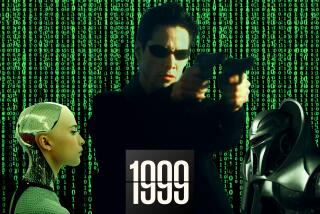From ‘Interstellar’ to ‘2001,’ five philosophical sci-fi epics
Perhaps more than any other genre, sci-fi movies ask, “What if?”
In their attempts to address that question, filmmakers have given audiences a bewildering array of sights, sounds and ideas over the years: the dystopian grit of “Blade Runner,” the space operatics of “Star Wars,” the martial-arts mayhem of “The Matrix” and the immersive thrills of “Gravity,” to name but a few.
And then there are the films you might call sci-phi — those that combine the hard edge of science with a philosophical exploration of Big Ideas about life, love, space and time. The latest entry in the subgenre is the three-hour epic “Interstellar,” which hit theaters last week and was just edged out of the No. 1 box-office spot by Disney’s “Big Hero 6.”
Time will tell whether “Interstellar,” which has garnered positive but not always effusive reviews, ultimately joins the pantheon of science-fiction greats. In the meantime, here’s a look at it and four more sci-phi dramas with a lot on their minds. (Some plot details, but no major spoilers, ahead.)
“Interstellar” (2014)
Who made it: Christopher Nolan directed from a script he co-wrote with his brother Jonathan. The original idea for the film was conceived by producer Lynda Obst and physicist Kip Thorne, and Steven Spielberg had been attached to direct.
What it’s about: In a near future where the Earth is turning into a giant dust bowl, a single dad and erstwhile pilot (Matthew McConaughey) joins a space mission to travel through a wormhole — presumably placed near Saturn by kindhearted five-dimensional beings — to find a new home for humanity.
What it’s really about: For all its technical wizardry and scientific prowess (Thorne was a scientific consultant on the movie), “Interstellar” has a warm, gooey center. It’s a parable about ambition (humanity’s, yes, and also Nolan’s) and most of all a story about the power of love.
Quote that sums it up: “Love is the one thing that transcends time and space.”
“Contact” (1997)
Who made it: Robert Zemeckis directed the film, which was adapted by James V. Hart and Michael Goldenberg from the novel by Carl Sagan. Sagan and wife Ann Druyan wrote the story outline for the film.
What it’s about: A SETI scientist (Jodie Foster) decodes a radio signal sent from an extraterrestrial source that contains plans for a machine of unknown purpose. She eventually pilots a version of the machine through a series of wormholes and converses with an advanced intelligence about humanity and its future, but when she returns, all evidence of her journey has been lost.
What it’s really about: Science, faith and whether the two can be reconciled. Foster’s character represents the former, while “Interstellar” leading man McConaughey pops up as a spokesman for the latter. Naturally, each has something to learn from the other.
Quote that sums it up: “As a person of faith I’m bound by a different covenant than Dr. Arroway. But our goal is one and the same: the pursuit of truth.”
“2001: A Space Odyssey” (1968)
Who made it: Stanley Kubrick directed the film from a screenplay he co-wrote with Arthur C. Clarke. It was partially inspired by Clarke’s short story “The Sentinel.” Clarke also wrote a novel version of “2001” and three sequel books, the first of which was also made into a film.
What it’s about: An astronaut (Keir Dullea) and his colleagues embark on a secretive mission to Jupiter to investigate a series of mysterious black monoliths. While en route, the ship’s sentient computer, HAL 9000 (voiced by Douglas Rain), goes AWOL.
What it’s really about: “2001” is famously ambiguous and open to interpretation. Clarke once said of the film, “If anyone understands it on the first viewing, we’ve failed in our intention.” But it’s clear enough that at the very least, the film explores the evolution of humanity — from protohuman to creator of life (via artificial intelligences like HAL) to posthuman “starchild” — and the various follies along the way.
Quote that sums it up: “I am putting myself to the fullest possible use, which is all, I think, that any conscious entity can ever hope to do.”
“Solaris” (1972)
Who made it: Stanislaw Lem’s 1961 novel “Solaris” has been adapted for the screen multiple times, including as a Russian TV movie in 1968 and an American theatrical film (by Steven Soderbergh) in 2002, but the gold standard is Andrei Tarkovsky’s 1972 version.
What it’s about: A psychologist (Donatas Banionis) voyages to a space station orbiting a remote oceanic planet called Solaris, where mysterious manifestations of deceased loved ones have appeared.
What it’s really about: Whereas Lem’s original novel was concerned with the seeming impossibility of comprehending and communicating with another species, Tarkovsky’s film is an exploration of love and loss, grief and recovery.
Quote that sums it up: “You love that which you can lose: yourself, a woman, a country.”
“Close Encounters of the Third Kind” (1977)
Who made it: Spielberg wrote and directed the film.
What it’s about: Amid increasing UFO activity, a blue-collar electrical worker (Richard Dreyfuss) has a run-in with an alien spacecraft and becomes obsessed with mental images of a mountain. Not long after, a fleet of UFOs descends and makes contact with mankind.
What it’s really about: A classic everyman story and a testament to the power and potential of mutual understanding and communication.
Quote that sums it up: “I can’t describe it, what I’m feeling or what I’m thinking. This means something. This is important.”
Follow @ogettell for movie news
More to Read
Only good movies
Get the Indie Focus newsletter, Mark Olsen's weekly guide to the world of cinema.
You may occasionally receive promotional content from the Los Angeles Times.






